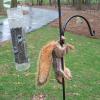Naturally carbing kegs = yeasty flavor
#1
 *_Guest_Matt C_*
*_Guest_Matt C_*
Posted 12 December 2011 - 02:24 PM
#2

Posted 12 December 2011 - 02:33 PM
#3
 *_Guest_Matt C_*
*_Guest_Matt C_*
Posted 12 December 2011 - 02:52 PM
Yep left it at (68-70F).....room temp. I don't think the carbonation would change any more than your bottles would. At that point the beer has absorbed any given c02 that was given off...at least in theory. Force carbing takes less time because the beer is cold,therefore the C02 is absorbed more readily.When you naturally carb a keg with priming sugar you leave it at room temp don't you? Basically like a big bottle. I'm looking at a 2.5g keg and will be naturally carbing that one. Just curious if the Co2 levels change once you put it in the fridge.
Have had trouble in the past with lagers and high gravity beers. I have a few bottles of barleywine that never carbed up because I never re-yeasted.Why bother re-yeasting? There should be plenty of yeast microbes in suspension.
#4

Posted 12 December 2011 - 02:53 PM
#5
 *_Guest_Matt C_*
*_Guest_Matt C_*
Posted 12 December 2011 - 03:08 PM
#6
 *_Guest_Matt C_*
*_Guest_Matt C_*
Posted 14 December 2011 - 05:10 PM
#7

Posted 14 December 2011 - 05:29 PM
#8

Posted 14 December 2011 - 05:36 PM
#9
 *_Guest_Matt C_*
*_Guest_Matt C_*
Posted 15 December 2011 - 05:58 PM
#10

Posted 16 December 2011 - 08:11 AM
I'll send a PM to Ken, he is the local beer clearing expert and ask him to take on this question.Go here to his website. He has a lot of good info about 2/3 down the page on how to produce clear beer.Cheers,RichI usually don't secondary even for lagers most of the time. I dry hop in the keg almost always. I have used gelatin and polyclar with little success in the past. In retrospect I am not sure I am using them correctly. What is the proper procedure for maximum effectiveness??
#11

Posted 16 December 2011 - 08:37 AM
I've found that if you have the time most of my beers will clear up without the use of gel - the gel just seems to make it happen faster. in cold temps yeast should floc out pretty well if that's really the issue.I usually don't secondary even for lagers most of the time. I dry hop in the keg almost always. I have used gelatin and polyclar with little success in the past. In retrospect I am not sure I am using them correctly. What is the proper procedure for maximum effectiveness??
Also tagged with one or more of these keywords: yeast, finings
Brewing Forums →
Beer →
Tried my new bluetooth Tilt Hydrometer and Omega OYL-057Started by StankDelicious , 09 Sep 2019 |
|

|
||
Brewing Forums →
Beer →
S-189 Dry Swiss Lager YeastStarted by Steve Urquell , 21 Apr 2016 |
|

|
||
Brewing Forums →
Beer →
Saving yeastStarted by neddles , 20 Aug 2013 |
|

|
||
Brewing Forums →
Beer →
Trappist yeast 3787 questionStarted by brewman , 09 Jun 2013 |
|

|
||
Brewing Forums →
Beer →
My DIY stir plateStarted by SteveMillerTime , 15 Apr 2013 |
|

|
0 user(s) are reading this topic
0 members, 0 guests, 0 anonymous users










